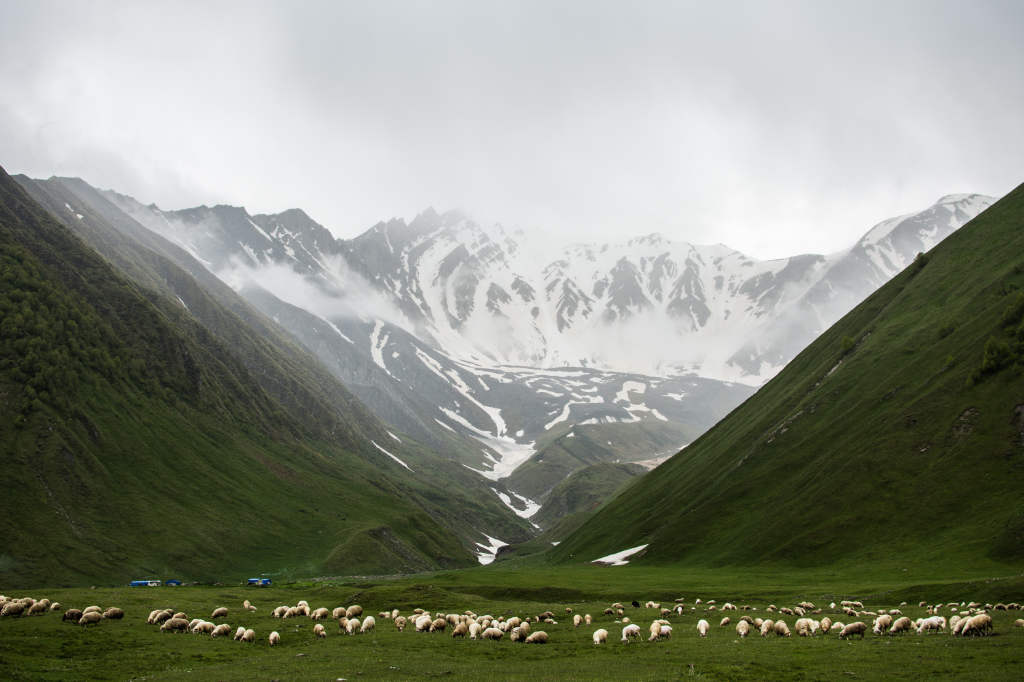
Feature: Merino Wool
Share
Merino wool is spun from the wool of Merino sheep. There are varying breeds of merino sheep, some are bred for their meat, but here we will focus on those bred for their wool. This wool is highly regarded because it is so soft, warm, lightweight, wrinkle resistant, breathable, stain resistant and biodegradable. Whew! The fibers are thinner than other types of sheep wool. Because of this, the fibers are more flexible and less itchy. We like that! Merino fibers wick away moisture so you feel dry and comfortable making it a great fiber for base layer garments and socks! [1] [2] But why do these fibers act in this way?
Merino are medium sized sheep that were known as early as the 12th century. The sheep often live under extreme conditions that only come from living in the mountains all year round. Exposure to extreme temperature fluctuations causes the fleece to become perfectly adapted to these conditions, thus, keeping the sheep cool in summer and warm in winter.[3] If the fibers can do that for these amazing sheep, they can do it for us, too.
Over centuries, some breeds of Merino sheep have been bred to produce the finest wool. They generally have white fleece consisting of crimped fibers that are generally 2 to 4 inches long and can produce as much as 40 pounds of wool in a year.[4] Wow! That’s a lot of wool.
With that amount of fluffiness comes a drawback. The sheep are so wooly that urine and feces stick to the wool surrounding the buttocks of the sheep. This attracts a species of blowfly, which would lay eggs that would hatch and burrow into the skin making the sheep vulnerable to a parasitic infection known as myiasis. To prevent this, a practice called mulesing began. This procedure involves cutting flaps of skin around the lamb’s breech and tail to promote an area of bare skin scar tissue to form making it less likely to attract flies. The practice was widely used in Australia. This practice has caused many retailers and dyers to boycott purchasing wool from producers who engage in this practice.[5] New Zealand and South Africa have banned the practice. The blowfly does not exist in South America due to the climate. [6]
Being so fluffy and producing so much fleece, the sheep must be shorn at least once a year since the wool dos not stop growing. As we already saw, not shearing the sheep can have health implications. [7] Many farmers and herders consider the merino sheep their livelihood and make it their priority to care for and look after their livestock. These sheep are grazing their natural habitat and protected and highly regarded by their herders. The wool produced by these sheep is of exceptional quality.[8] Here's to the efforts of herders who care for and respect their herds!
Until next time...
Linda
XO
Check out some of our other topics: yarn draft, fibers, gauge, needles, twist, ply and weight
Why avocado?
Breaking down your yarn needs
Our origin story
My yarn journey
[1] Merino 101: Retrieved from: https://www.smartwool.com/discover/what-is-merino-wool.html
[2] Fibre. Retrieved from: https://www.woolmark.com/fibre/
[3] Worlds Finest Wool. Merino Sheep. Retrieved from: https://www.worlds-finest-wool.com/merino/the-merino-sheep/
[4] Worlds Finest Wool. Merino Sheep. Retrieved from: https://www.worlds-finest-wool.com/merino/the-merino-sheep/
[5] What is mulesing? RSPCS Knowledgebase. Retrieved from: https://kb.rspca.org.au/knowledge-base/what-is-the-rspcas-view-on-mulesing-and-flystrike-prevention-in-sheep/#:~:text=What%20is%20mulesing%3F,of%20bare%2C%20stretched%20scar%20tissue.
[6] Pasuali. Some Thoughts and Facts About Wool. Retrieved from: https://www.pascuali.de/en/blog/knit-blog/to-know/wool-sheep
[7] Knitpal. Retrieved from: https://knitpal.com/blogs/knitpal/your-guide-to-merino-wool-and-yarn
[8] Knomad. Retrieved from: https://www.knomadyarn.com/blog/sustainability-at-knomad-renewable-energy-and-protecting-natural-resources/
